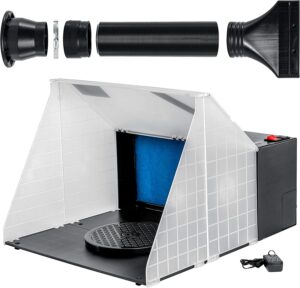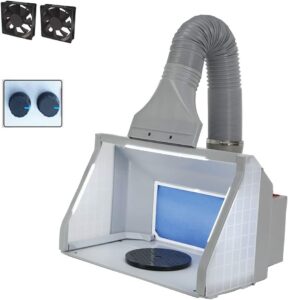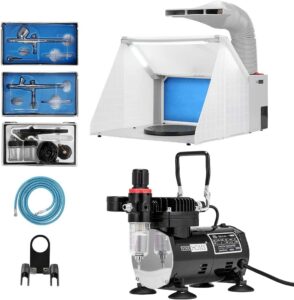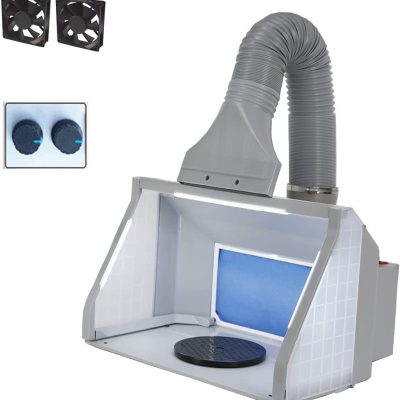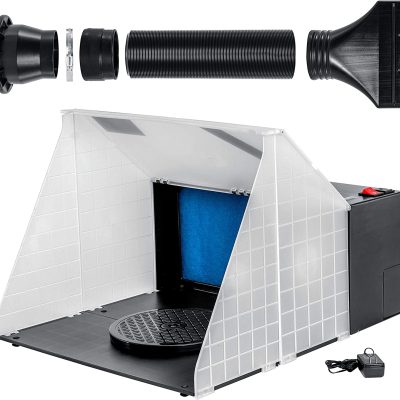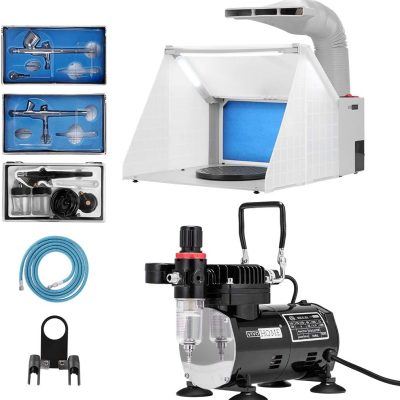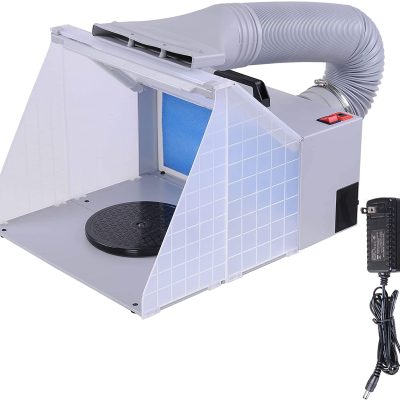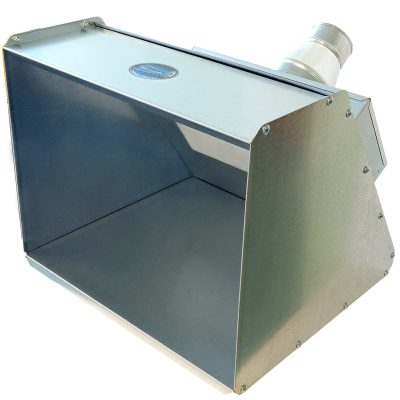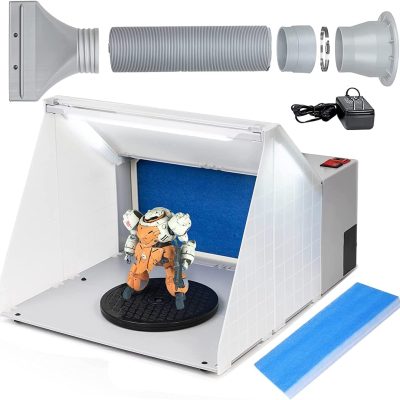- Last Updated: January 12, 2024
-
 Pat Nathaniel
Pat Nathaniel
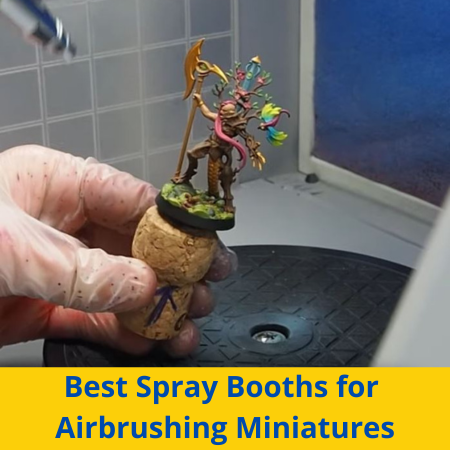 Whether you’re mustering a vast Space Marine army for Warhammer 40,000 or painting historically-accurate scale models, an airbrush makes doing that much easier. But airbrushes are prone to spewing tiny paint particles and harmful fumes into the air.
Whether you’re mustering a vast Space Marine army for Warhammer 40,000 or painting historically-accurate scale models, an airbrush makes doing that much easier. But airbrushes are prone to spewing tiny paint particles and harmful fumes into the air.
That’s why you need an airbrush spray booth.
Not only does the booth catch overspray, but its fans also vacuum up fumes and vapors. It makes airbrushing neater, easier, and safer.
Yet, you have to buy the right booth for your models and workspace. A hastily purchased booth can’t clean the air and is only a big waste of money.
Read on to find out which ones are the best airbrush spray booths for your miniatures.
Table of Contents
- Best Spray Booths For Airbrushing Miniatures At A Glance
- 1. OPHIR Double Fans Airbrush Spray Booth Kit (Best Choice)
- 2. Master Airbrush Portable Hobby Airbrush Craft Spray Booth (Best Value)
- 3. VIVOHOME Professional Airbrushing Combo Set (Premium Choice)
- 4. AW LED Light Portable Airbrush Paint Spray Booth Kit (Most Affordable)
- 5. Paasche HSSB-22-16 Hobby Spray Booth (Largest and Most Rugged)
- 6. Autolock Airbrush Lighted Hobby Spray Booth Kit (Most Reliable)
- Use Your Airbrush Spray Booth Right
- Do You Need a Spray Booth When Airbrushing Miniatures?
- How to Use an Airbrush Spray Booth for Miniatures?
- What is the Best Airflow for a Spray Booth?
- What Type of Fan Should I Use for a Spray Booth?
- How to Maintain a Spray Booth?
- What to Look for in an Airbrush Spray Booth
- How to Make a DIY Airbrush Spray Booth?
- The Best Airbrush Spray Booth for Your Miniatures
Best Spray Booths For Airbrushing Miniatures At A Glance
1. OPHIR Double Fans Airbrush Spray Booth Kit (Best Choice)
2. Master Airbrush Portable Hobby Airbrush Craft Spray Booth (Best Value)
3. VIVOHOME Professional Airbrushing Combo Set (Premium Choice)
4. AW LED Light Portable Airbrush Paint Spray Booth Kit (Most Affordable)
5. Paasche HSSB-22-16 Hobby Spray Booth (Largest and Most Rugged)
6. Autolock Airbrush Lighted Hobby Spray Booth Kit (Most Reliable)
Workspace: 548 x 327 x 290 mm | Air Flow: 9m3 /min | Lighting: LED | Noise Level: 53db | Fan Power: 45W
Are you hankering to start painting and don’t want to spend much time picking your booth? Then get the OPHIR spray booth system.
This is one of the best portable spray booth kits you can find.
First of all, this booth has seriously strong adjustable fans. Case in point — if you light a cigarette (not that I encourage smoking), the fans will suck it up four inches outside the workspace.
Although you should always wear a mask, you won’t have to worry about chemical or paint fumes. A 5.6-foot flexible exhaust hose lets you direct the vapors out of any window.
Say goodbye to the headache — both literal and figurative.
Another fantastic feature is the adjustable LED lighting. You can change the intensity with a simple knob. The LEDs light the large workspace brightly (a bit too brightly at the maximum setting) and let you see your models’ colors in vivid natural hues.
If you have to clear your painting space often, OPHIR has you covered. The booth folds up into a compact suitcase for easy storage and transportation.
Would you like a cherry on top of your airbrush booth sundae?
This booth comes with a turntable. It’s a priceless addition to the kit and makes priming and base coating so, so much easier. You’ll never want to go back to tacking your models on a spraying stick, believe me.
But what about the downsides? Well, the booth is a bit noisy, clocking in at around 60db with both fans at maximum power.
Look, just put earbuds on and play some music to block it out. This is the only airbrush spray booth you’ll ever need.
Pros
- Powerful double fans
- Adjustable fans and lights
- Large spray area
- Comes with a turntable
Cons
- Fans are a bit loud
- On the pricey side
Workspace: 482 x 419 x 343 mm | Air Flow: 4m3/min | Lighting: LED (Optional) | Noise Level: 47db | Fan Power: 25W
You’ve already spent a lot of money on your models, paints, and airbrush. Sure, you need a spray booth, but you’d really like the most bang for your remaining bucks.
The Master Airbrush spray booth brings you the high value you seek.
With this booth, you can paint your models and miniatures safely without breaking the bank.
Although the fan power and suction are only about half of OPHIR’s, they vacuum up spray paint particles, fumes, and vapors efficiently. The fans are also relatively quiet, so you won’t alert the whole neighborhood when you start painting.
The booth has a well-sized work area, although the width is fairly limited. But that’s fine — just buy another unit and combine them.
That’s right, the kits are modular. And at this price, you can afford two of them. If you can’t fit your model into that space, it’s not a miniature anymore.
Like OPHIR, Master Airbrush has included a turntable in the kit, which alone makes it worth buying. And the whole thing folds up small enough that it fits on your bookshelf.
Unfortunately, the booth doesn’t come with lights installed. You can buy LED lights from Master Airbrush, but they have a blueish tint that could throw off your colors. Maybe consider getting your lights elsewhere.
The booth is also made of plastic, so don’t bang it against anything. You could crack it easily.
But those are the compromises you have to make to get such a good booth at this price.
Pros
- Great value
- Modular design
- Turntable
- Fairly quiet
Cons
- Doesn’t include lights
- Fragile casing
Workspace: 419 x 358 x 343 mm | Air Flow: 9m3/min | Lighting: LED | Noise Level: 47db | Fan Power: 25W
If you paint miniatures for modeling competitions or as commissions, you need serious tools. VIVOHOME’s airbrush combo set is the stuff professional painters dream of.
Let’s start with the spray booth — it just works.
VIVOHOME looks a lot like the Master Airbrush booth. So much so, in fact, that you might think they’re the same. But the devil is in the details.
VIVOHOME has twice the airflow, matching that of the OPHIR even though it has only half the fan power. That tells you just how efficient the fans are. They will suck up any fumes and paint particles, and the latter get safely trapped in the double fiberglass filter.
The three LED lights (included as standard) produce bright white light that lets you see your model’s colors accurately. And it has an anti-slip-coated roundtable
Like I said, it just works.
But now for the big catch. The combo set comes with a compressor and three airbrushes.
Granted, they aren’t the best tools on the market. But they’re good enough that they make the combo set worth it for both pros and newbies.
“But what if I don’t need another compressor and airbrush?” you ask. That’s fine. You can buy the spray booth on its own — and the lower price actually gives it pretty crazy value.
VIVOHOME Professional spray booth is exactly what it promises: professional. The decent airbrush only makes it better.
Pros
- Good fan performance
- Bright LED lights
- Anti-slip turntable
- Compressor and airbrush in the combo set
- Booth also available individually
Cons
- Plastic casing
- The airbrush could be better
- Small workspace
Workspace: 420 x 380 x 340 mm | Air Flow: 4m3/min | Lighting: LED | Noise Level: 47db | Fan Power: 25W
Sometimes the cheapest option can be the best one. Modelers who just want a functional airbrush paint booth at the lowest possible price won’t be disappointed with this AW product.
Performance-wise, there’s not much to say about the AW booth. It’s practically identical to the Master Airbrush booth, with the same perfectly sufficient airflow, fan power, double fiberglass filter, turntable, and low-ish noise level. It does come standard with LED lights, though, so it has that going for it.
In fact, AW and Master Airbrush (and Autolock) are so similar that I’m fairly sure their parts came off the same assembly line. The only difference is who put them together and slapped the brand stickers on them.
That’s not necessarily a bad thing, though. You know you’ll get the same reliable vacuum performance.
AW trumps its relatives (or clones) in price, though. It’s a very affordable and highly portable spray booth. If you’re browsing for cheap but good airbrush spray booths, you might as well stop your search at AW.
That said, you can start to see that AW has cut corners with this booth to beat the competition. First of all, the booth is supposed to have a retractable power cord—but don’t count on it retracting for very long.
Additionally, the already shaky plastic walls aren’t attached very well to each other. It’s common for the joints to pop off their hinges. You might want to consider gluing them in place, although then you can’t fold the booth up.
With the AW spray booth, you get what you pay for. It’s far from perfect, but it’ll get the job done on a budget.
Pros
- Cheap
- Reliable suction
- Standard lights and turntable
Cons
- Flimsy construction
- Small-ish spray area
Workspace: 560 x 510 x 405 mm | Air Flow: 7m3/min | Lighting: None | Noise Level: 47db | Fan Power: 115 volts
If you build larger miniatures — like 1:200 scale ship models — you’ll need a lot of space for painting your masterpieces. Paasche’s airbrush spray booth will fit even the biggest scale models.
This behemoth of a booth has the largest workspace out of any product featured on this list. It works for models, but it’s also fit for more general DIY projects. You can spray paint decently-sized sculptures, clothes, or machinery in this booth.
But let’s address the elephant in the room.
Paasche’s spray booth isn’t made of wobbly plastic. It’s an all-metal piece of heavy-duty equipment made of galvanized panels.
The heavy construction makes this booth extremely sturdy and easy to clean. You can use chemicals to wipe away paint that would only corrode plastic spray booths.
With such industrial-grade construction, it’s a real pity that the booth is otherwise kind of underwhelming.
First of all, there are no lights. None at all. The booth doesn’t even have holes or hooks for you to attach your own LED strips to it. Hope you like working with a headlamp on.
The fan power also doesn’t match the size of the spray area. It’ll suck up most of the paint fumes and particles, but you definitely need a mask. This is also the only booth to not have a turntable.
Also, although this booth comes unassembled, it’s not meant to fold up like the plastic ones. Once you’ve set it up, don’t expect to move it.
In the name of honesty, Paasche’s spray booth has some serious drawbacks. But if a large workspace and rugged build are what matter to you, it does have those in spades.
Pros
- Huge spray area
- Built like a tank
- Simple assembly for a metal booth
Cons
- Expensive
- No lights or turntable
- Non-collapsible
- Weak fan and no included hose
Workspace: 419 x 482 x 343 mm | Air Flow: 4m3/min | Lighting: LED | Noise Level: 47db | Fan Power: 25W
Do you think the Autolock spray booth seems familiar? No wonder — it’s yet another addition to the Master Airbrush/AW army of clones.
If you’ve read this entire list, you already know what Autolock’s booth is capable of. But if you scrolled past everything else to this review, you’re looking at a booth that does a good job venting paint fumes.
Nothing more, nothing less.
Autolock has the same fairly big spray area that you find on the Master Airbrush, beating the AW model. That should be further proof that these booths are built on the same platform. The fans have decent power and provide adequate airflow through the double fiberglass filters to clear the workspace of particles and vapors.
So why should you buy this booth instead of one of the other two similar ones?
Compared to the lightless Master Airbrush, Autolock comes with three LED strips. That’s an instant win, even though you can’t combine two of these units into one massive booth.
Autolock is comparable in price to the AW model but has a larger workspace. It also feels a bit better built so you won’t have to worry about the whole booth falling apart if you sneeze.
Who is this booth for, then? It’s for modeling hobbyists who don’t want or need anything flashy and fancy. The Autolock portable airbrush spray booth does exactly what it promises — it sucks up your paint exhaust and gives you a well-lit and decently-sized painting space at a nice price point.
Pros
- Affordable
- Reliable vacuum performance
- Turntable
- Well-sized spray area
Cons
- Plastic construction
Use Your Airbrush Spray Booth Right
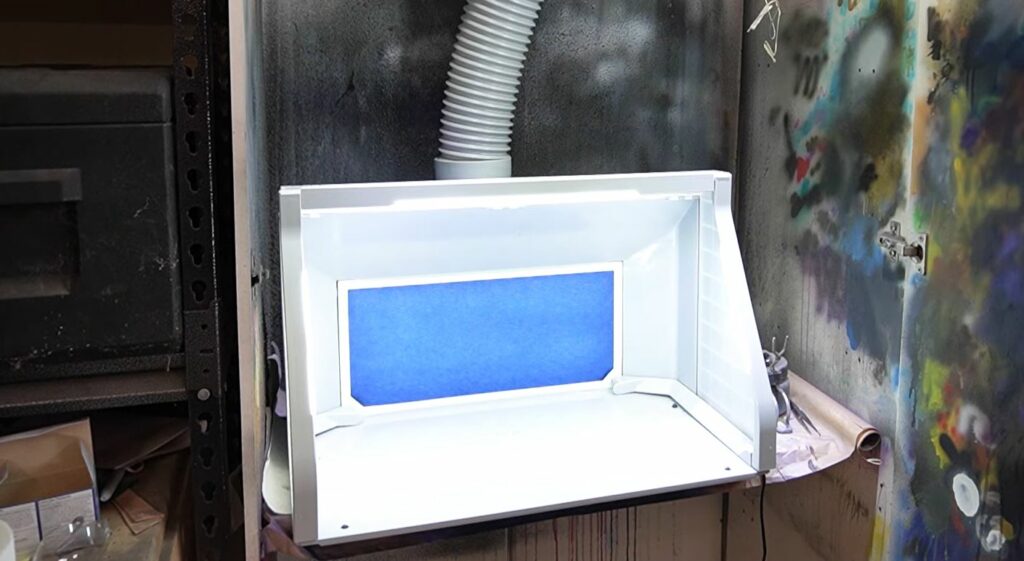
An airbrush is a great addition to any modeling and miniature hobbyist’s toolbox. A spray booth makes using your airbrush neater, safer, and more convenient.
But you shouldn’t buy a spray booth blindly. Without some pre-planning, you might end up with an undersized booth that does more harm than good, or you could blow hundreds of dollars for more performance than you’ll ever use.
Let’s take a look at everything you need to know about airbrush painting booths.
Do You Need a Spray Booth When Airbrushing Miniatures?
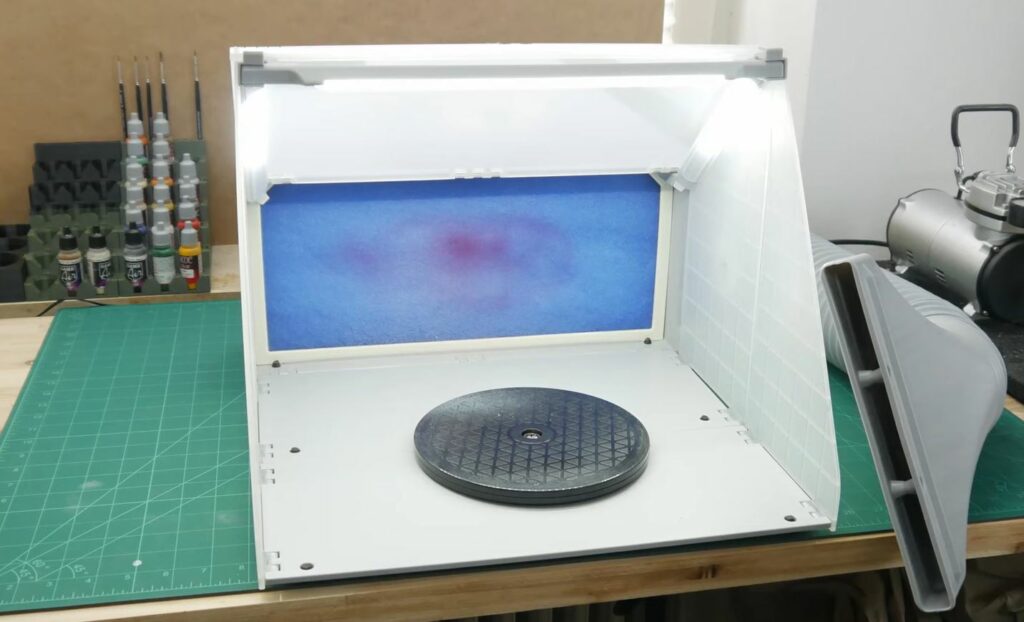
You don’t need a spray booth to paint miniatures and models with an airbrush. You can airbrush your miniatures perfectly well without one — although I will have to insist that you wear a respirator mask.
An airbrushing booth simply makes the painting process less messy and risky. To begin with, you will always have some overspray (paint that flies past your model) with airbrushes. A spray booth catches that overspray and spares you the effort of spreading old newspapers all over the place.
Additionally, airbrushing creates paint fumes and sends atomized paint wafting through the air. A spray booth’s motorized fan sucks up that exhaust and vents it outside, while the fan filter soaks up stray paint particles. You can paint without worrying too much about inhaling potentially toxic vapors.
Finally, if your booth has lights, you can always paint your models in a well-lit environment that reflects the colors of your paints accurately. And that means your miniatures will look better once they’re done.
So, the bottom line is that you don’t necessarily need a spray booth — but it does make your airbrushing projects a whole heck of a lot simpler and more comfortable.
How to Use an Airbrush Spray Booth for Miniatures?
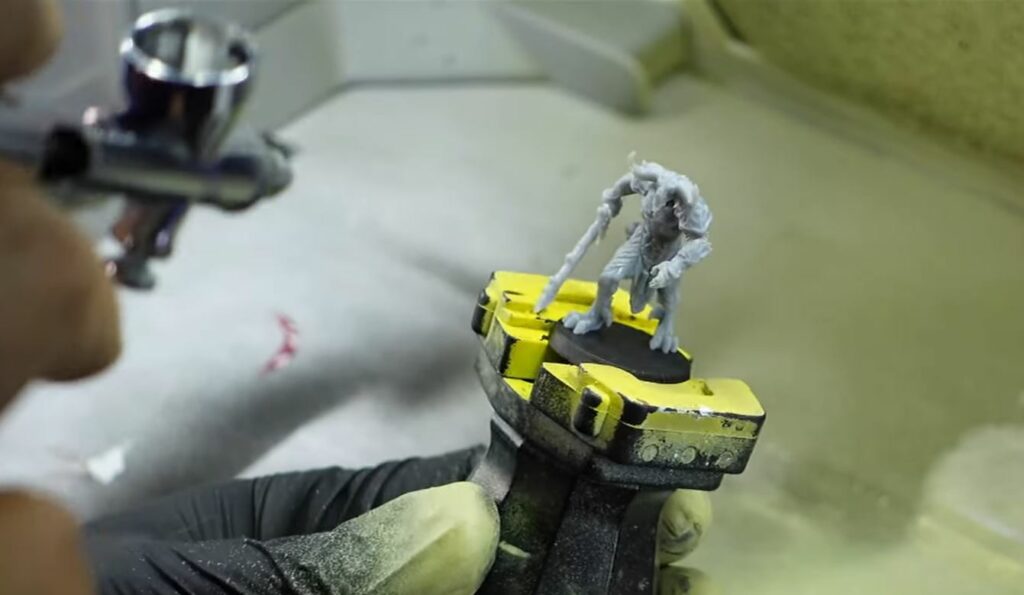
Airbrush spray booths aren’t tricky to use, but if you’ve never owned one, you might wonder how you’re supposed to work with it.
The exact steps depend on your booth and its features, but in general, you can follow these steps to paint your miniatures:
- Set up your booth on a steady desk in a well-ventilated room, unfolding it if it’s a collapsible model.
- Extend the exhaust hose and mount it to a cracked-open window or door. Use some masking or duct tape to hold it in place if necessary.
- Plug the power cord in (unless your booth is battery-powered) and switch on the fans and lights.
- Adjust the fan speed and light intensity to appropriate levels if your booth has power settings.
- Set up your airbrush compressor and start painting! Try to work as deep inside the booth as is practical and comfortable to ensure it can suck up as much paint residue as possible.
- Once you’re done, take out the filter and clean it according to the manufacturer’s instructions. Replace it with a new one regularly to maintain the booth’s vacuum performance.
After you’re done painting, you can disassemble the booth and fold it away to free up some desk space. I would recommend setting your spray booth up somewhere you won’t have to constantly move it to save yourself the hassle, though.
What is the Best Airflow for a Spray Booth?
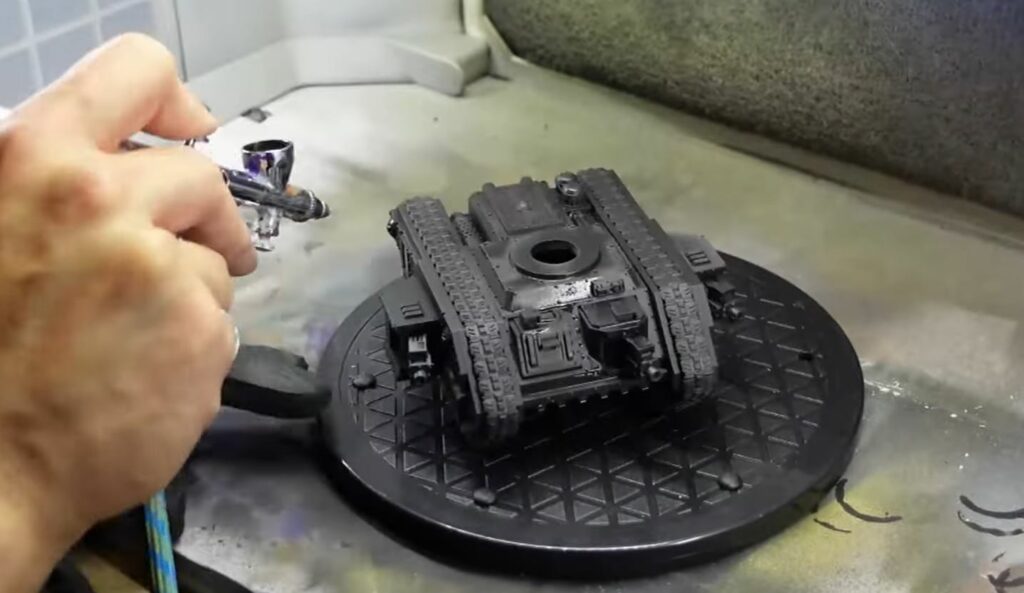
The best airflow for a spray booth depends on what you’re spraying and how you’re doing it. For the average miniature or modeling hobbyist looking to paint models with an airbrush, an airflow of 4m3/min is sufficient. Of course, the higher the airflow, the better the booth can vacuum up fumes, vapors, and paint.
You might be tempted to also use your booth for spraying miniatures (or something else) with spray can paints. Don’t do that. Hobbyist-grade spray booths don’t have enough airflow to remove exhaust and vapors from spray cans.
Spray can paints and primers — in other words, aerosol sprays — contain volatile organic compounds that can be dangerous and even toxic. Additionally, aerosol sprays are flammable, and a poorly wired hobby-level booth could cause a spark.
For spray cans, you’ll need a professional-grade spray booth with much higher airflow. It’s best to always use aerosol sprays outside.
What Type of Fan Should I Use for a Spray Booth?
In general, any kind of fan that offers sufficiently high airflow can work with an airbrush spray booth.
That said, you’re best off choosing a dedicated ventilation fan that’s designed to move large amounts of air. Something like a ventilation duct fan, a dryer fan, or a squirrel cage fan will serve you well.
When picking a fan for your booth, make sure it’s safety-certified against sparking and moisture. Some fumes from airbrush paints and primers could be flammable. Pay attention so you don’t blow yourself up.
How to Maintain a Spray Booth?
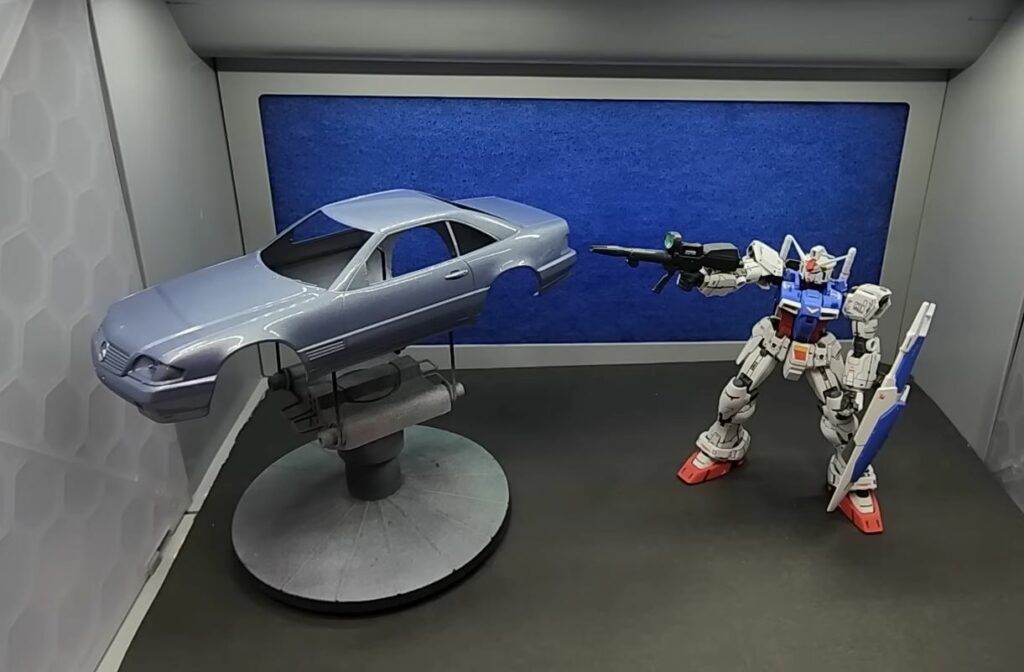
- Wash and switch the filter regularly to maintain airflow and suction power.
- Clean off overspray and chemical spills from the inside of the booth, the fan, and the exhaust hose. Use cleaning solutions that won’t damage the booth’s components.
- Use the booth in a dry environment and always let it dry properly after washing.
- Blow dust and debris out of the booth and fans before turning them on to maintain efficiency and prevent fires.
What to Look for in an Airbrush Spray Booth
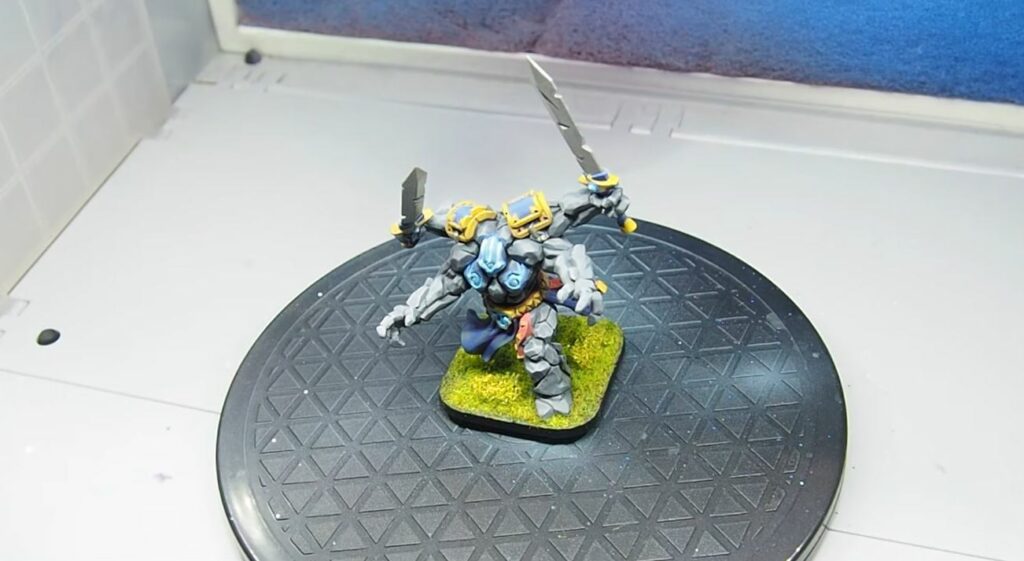
When shopping for airbrush spray booths, your should pay close attention to the small details to make sure you get a booth that works for your hobby and workspace. Here are the most important considerations to keep in mind:
Size
Pick a booth that’s large enough to fit the kinds of models and miniatures you build/print and paint. Naturally, the whole booth will be completely pointless if your giant Gundam or WW2 battleship won’t fit in it.
Ventilation System
Spray booths usually have one of two kinds of ventilation systems: a simple fan or an exhaust hose.
The fan system improves air circulation and removes paint residue from the air, but doesn’t vent fumes or vapors. The exhaust hose system can move harmful fumes away from the booth and vent them outside, but it’s more difficult to set up and may be more expensive.
Lighting
You can’t paint in the dark. I recommend choosing a spray booth that comes with neutral, white LED light strips. They will light up the spray area brightly and won’t distort your paint colors.
Portability
If you know you’ll have to move your spray booth off your hobby desk occasionally, pick a booth that can fold up into a smaller size for easy storage. That said, I’d recommend setting up a space where you don’t have to move your booth — simply because constantly assembling it is a pain in the ***.
Noise Level
Nobody likes the whirr of a spray booth’s fans, but a whisper-quiet system will likely not have enough suction power to clear the air. Look for a model with the right balance between fan power and their decibel levels.
Power Source
Spray booths can be powered either through a cord or a battery. A corded system is usually better since you won’t risk running out of battery, although you may have to mess with extension cords to reach an outlet.
Value
Spray booths come in a wide range of prices. Decide your budget before you start browsing so you can look for a booth with the most features within your price range.
Features
Look for things like adjustable fan power and lighting, included paint accessories, turntables, and other quality-of-life goodies. They make painting your models much more convenient and easier.
How to Make a DIY Airbrush Spray Booth?
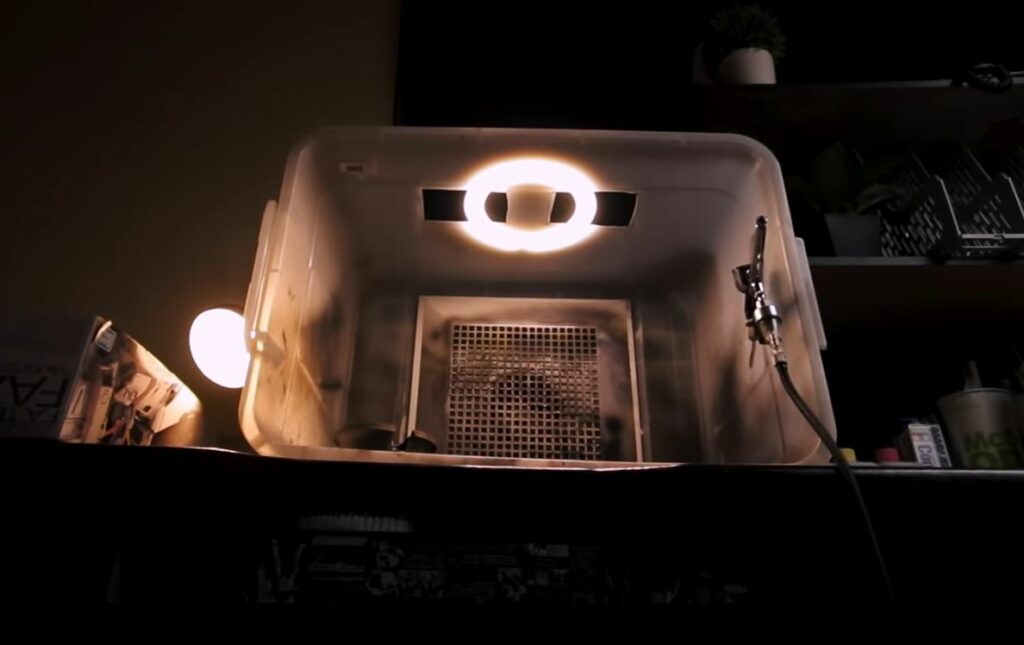
You don’t necessarily need to buy an airbrush spray booth. You can build your own relatively easily with basic DIY skills.
Here’s what you need to make a basic DIY spray booth:
- A large plastic tub for the spray area
- A fan with sufficient airflow (and possible adapters)
- A spray filter
- A power source
- A flexible hose
- An LED strip
And here’s what to do:
- Make a round hole that matches your fan’s diameter at the bottom of the tub.
- Follow the included installation instruction to attach the fan to the hole with screws or bolts.
- Wire the fan to the power source (unless it has its own power unit and cord).
- Tape the spray filter to the bottom of the tub over the fan vent.
- Attach the hose to the fan’s exhaust outlet or vent.
- Fix the LED strip to the top of the tub with tape.
Congratulations, your DIY spray booth is ready. It’s probably not as efficient as a professionally-built one, but it can get the job done.
The Best Airbrush Spray Booth for Your Miniatures
You now know a lot about airbrush spray booths, but you may still feel a bit lost with all the options. Here are my recommendations for the best hobby airbrush spray booth.
- The OPHIR double fan booth offers a great balance of size, features, and affordability.
- Airbrush Master is an affordable and modular option.
- Depending on your needs, VIVOHOME and Paasche are good options for professional miniature painters.
- If you want a booth that just works without a hassle, go for the Autolock one.




